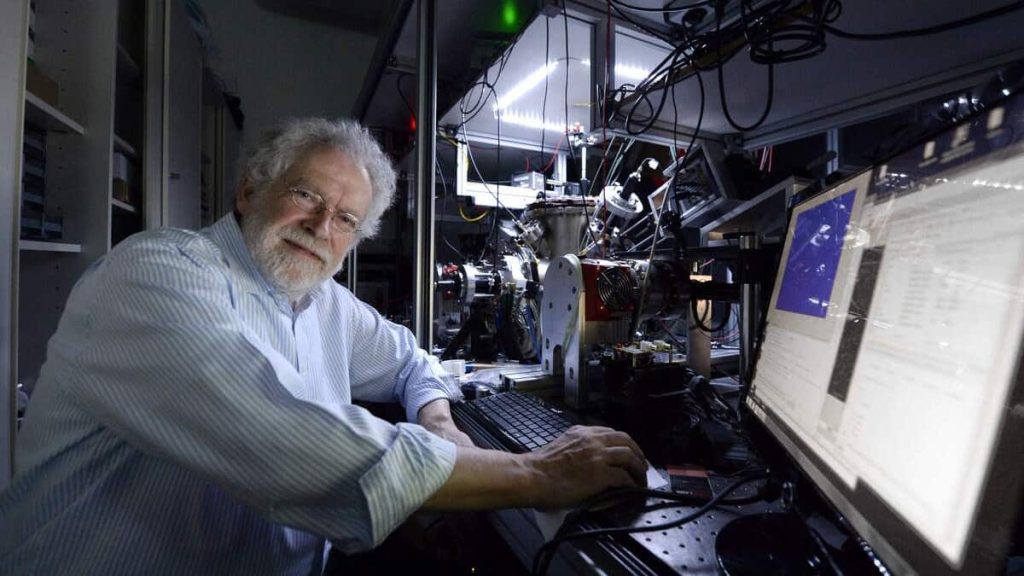The winners of the 2022 Nobel Prize in Physics have been honored for their work on “quantum entanglement”: a phenomenon so strange and unlikely that Albert Einstein didn’t believe it. which he described as “terrifying”.
Even today, many physics graduates still do not understand the phenomenon of entanglement, also known as “entanglement,” says Chris Phillips, a physicist at Imperial College London.

France Press agency
Take the example of a photon, a particle of light. By passing it through a special crystal, two photons come out. “They don’t have the same original color, but since they come from the same photon, they are entangled,” he explains to AFP.
The measurement of properties that we do on one, by examining it, immediately affects the other, no matter how far apart they are. The two entangled particles behave identically, as if they were connected by an invisible thread.
Chris Phillips saw this “very strange thing” in his lab, which houses two entangled photon beams. “I can put my hand in one of the beams and something happens instantly in the second beam on the other side of the room, as evidenced by an instrument” on this second beam, he says.

France Press agency
And it was this idea of immediacy that bothered Einstein, because nothing, be it an object or information, is supposed to be able to move faster than the speed of light.
In 1935, the founder of the theory of relativity questioned an essential component of quantum entanglement, non-locality, which he described as the “frightening effect at a distance.” Because it violates, according to him, the principle of place, that is, the fact that a thing can be affected only in its immediate environment.
To explain the effect of entanglement, the existence of ‘hidden variables’, i.e. the forces at work, is then assumed, but they are still unknown.
In 1964, Northern Irish physicist John Stuart Bell found a way to verify this with the inequality theory that bears his name. But it still needs to be tested by a scientific experiment.

France Press agency
This is what French physicist Alain Aspect accomplished after two decades in his laboratory. It proves that two entangled particles of light are entangled in such a way that the measurement of the properties of one affects the properties of the other instantly.
By testing its limits, he and his team demonstrated that “quantum mechanics resists all possible attacks,” Alan Aspect said in an interview published by the Nobel Foundation on Tuesday, after awarding him its prize.
This reward certainly proves Einstein wrong, but the French physicist is very grateful to him.
“I would say that a great merit is due to Einstein for posing the question of ‘decentralisation, one of the foundations of entanglement,’ asserts Alan Aspect.
He himself admits the difficulty of accepting the idea of decentralization “as a mental picture, something totally crazy”.
The Nobel Prize winners in Physics, Austrian Anton Zeilinger and American John Clauser, also tested Bell’s theory and ruled out any other explanation for the non-local explanation. Their work paved the way for what is known as the “second quantum revolution”.
The discoveries of Zeilinger, nicknamed “the popular quantum man”, showed the potential application of entanglement in cryptographic communications, quantum teleportation and so on.
High-tech companies are investing huge money in developing quantum computers that promise unparalleled computing capabilities.
For his part, Chris Phillips has developed a tool, about the size of a high-resolution stereo, that uses quantum entanglement to diagnose breast cancer.
But the biggest mystery of quantum entanglement remains unsolved, nearly a century after Albert Einstein’s interest: How does it happen?
“We have to be humble about the physics,” says Chris Phillips. “It simply exists.”

“Total coffee aficionado. Travel buff. Music ninja. Bacon nerd. Beeraholic.”






More Stories
Fluoroscopy | “Self-coup”?
This is why you find it difficult to wake up in the morning.
She meets her boss at the airport after taking sick leave.